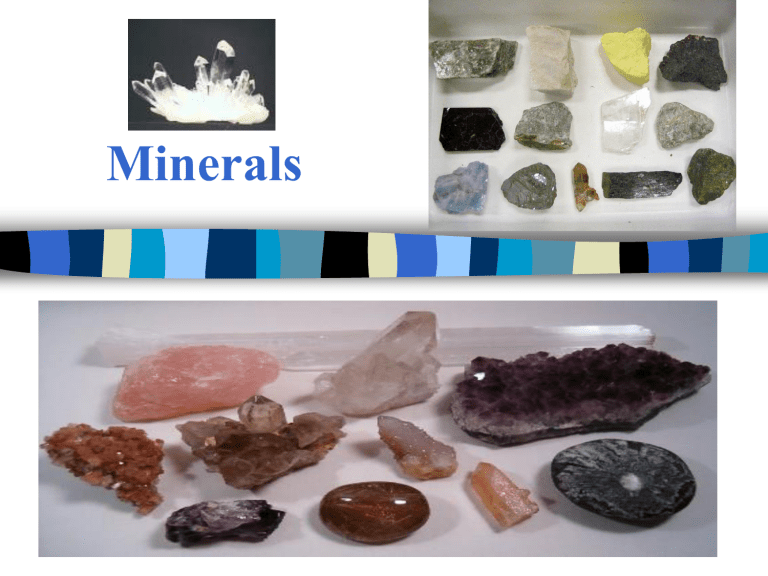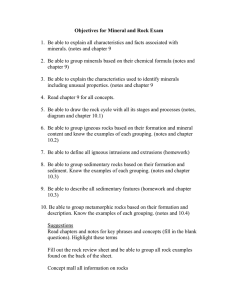Minerals
advertisement

Minerals A. What is a mineral? Mineral Characteristics shared by all minerals: 1. Natural – occurs naturally – NOT manmade What is a mineral? 1. Natural 2. Inorganic – Is not alive – Was never alive What is a mineral? 1. Natural 2. Inorganic 3. Crystalline – Atoms are arranged in an orderly pattern What is a mineral? 1. Natural 2. Inorganic 3. Crystalline 4. Definite chemical composition – Chemical formula – SiO2 is Quartz What is a mineral? 1. Natural 2. Inorganic 3. Crystalline 4. Definite chemical composition 5. Solid – Not a gas, not a liquid How will we remember this? Natural Inorganic Crystalline Definite chemical composition Solid Mineral Characteristics shared by all minerals: Now I Can Define mineralS! Natural Inorganic Crystalline Definite chemical composition Solid B. Physical Properties of Minerals 1. Color – First impression – Not very reliable because lots of minerals can occur in many different colors Quartz Purple Amethyst Fluorite •Clear •Blue •Green •Purple Physical Properties of Minerals 1. Color 2. Streak – The TRUE color of a mineral – Color of a mineral’s powder Physical Properties of Minerals 1. Color 2. Streak 3. Hardness 4. Cleavage 5. Fracture 6. Luster – How light shines off a mineral – Metallic or Nonmetallic Physical Properties of Minerals: Used for Identification (I.D.) Color Streak Hardness Cleavage Fracture Luster 3 types of rocks 3 types of rocks There are 3 types of rocks found on Earth: – Igneous – Sedimentary – Metamorphic Knowing the differences between these 3 types of rocks allows us to learn about Earth’s Igneous Rocks - Formation Igneous Rocks are formed by melting, cooling, and crystallization of other rocks. Igneous rocks form as a result of volcanic activity, hot spots, and melting that occurs in the Igneous Rocks - Classification Igneous rocks are classified using their texture in the following ways: – Glassy – Aphanitic (no visible crystals) – Phaneritic (visible crystals) – Porphyritic (Some visible and some not visible crystals) Types of Igneous Rock Intrusive- Forming a large crystals that the magmas cools down very slowly Ex. Granite Extrusive- they form an amorphous glass Ex. Basalt Sedimentary Rocks - Formation Sedimentary rocks are formed by weathering, erosion, deposition, compaction, and cementation of other rocks. Sedimentary rocks form in areas where water, wind, or Sedimentary rocks - formation Sedimentary rocks are likely to form in areas such as: – – – – – – – Deltas Beaches Rivers Glaciers Sand dunes Shallow seas Deep oceans Sedimentary rocks Classification Sedimentary rocks are classified into two groups: – Clastic rocks – Chemically formed rocks Sedimentary rocks – Classification Sedimentary rocks are Clastic if they are made of pieces of other rocks that have been weathered and eroded. Clastic rocks are grouped based on the size of grain that they are made from. Sedimentary rocks Classification Very small particles make up mudrock. Medium sized particles make up sandstone. Large particles make up conglomerates. Sedimentary rocks Classification Sedimentary rocks that form from chemical processes are called biochemical rocks (formed from living things) or Chemical precipitates (formed from lakes or shallow seas.) Sedimentary rocks - formations Structures and formations seen in sedimentary rocks include: – – – – – – Stratification Cross bedding Graded bedding Ripple marks Mud cracks Fossils Sedimentary rocks - Examples Some of the most common types of sedimentary rocks include: – – – – – – – Conglomerate Sandstone Shale Limestone Gypsum Oolites Chert (including black flint and red jasper) Metamorphic rocks - Formation Metamorphic rocks are formed by heat and pressure changing one type of rock into another type of rock. Metamorphic rocks form near lava intrusions, at plate subduction zones, and in deep mountain roots. Metamorphic rocks Classification Metamorphic rocks are classified into 2 major groups: – Foliated – Nonfoliated Metamorphic rocks Classification Foliated rocks form when differential pressure causes minerals to form in layers. These rocks will have stripes or planes that they will break easily along. These “stripes” don’t usually line up with the original bedding planes Metamorphic rocks Nonfoliated metamorphic rocks formed in areas where the pressure from all sides was equal, so there is no “linear” quality to the rocks. Metamorphic rocks - Formations Structures and formations seen in metamorphic rocks include: – – – – Folding Plastic deformation Stretching Alternating dark and light layers (gneissic foliation) Metamorphic rocks - Examples Some common types of metamorphic rock include: – – – – – – – Slate Schist Gneiss Amphibolite Marble Quartzite Metaconglomerate Metamorphic rocks - story What do you know about the history of the Earth in the place where this rock was found? FAULTS Deformation is the bending, tilting, and breaking of the Earth’s crust. Plate tectonics is the major cause of crustal deformation. When the hanging wall moves down it is called a normal fault. Normal faults occur in places where there is tension or the rocks are being pulled apart. When the hanging wall moves up it is called a reverse fault. Reverse faults are caused by compressional forces. A low angle reverse fault is called a thrust fault because one side is being thrust onto the other. The last type of faults are called strike-slip faults. Strike-slip faults slide horizontally past one another. Plate tectonics Plates are driven by cooling of Earth (convection) Gravity provides additional force to move plates. ? ? ? Modified from USGS Graphics Convection is like a boiling pot. Heated soup rises to the surface, spreads and begins to cool, and then sinks back to the bottom of the pot where it is reheated and rises again. What are the tectonic plates? AKA: Lithospheric plate The ~100-km-thick surface of the Earth; Contains crust and part of the upper mantle; It is rigid and brittle; Fractures to produce earthquakes. USGS Graphics What is the asthenosphere? Asthenosphere: Is the hotter upper mantle below the lithospheric plate; Can flow like silly putty; and Is a viscoelastic solid, NOT liquid!! Three Basic Types of Plate Boundaries Divergent Using hands to show relative motion Transform Convergent USGS Graphics Seafloor Spreading Source: http://www.tectonics.caltech.edu/outreach/animations/index.html Weathering Weathering is simply the chemical and/or physical breakdown of a rock material--weathering involves specific processes acting on rock materials at or near the surface of the Earth Weathering In other rocks, minerals may slowly dissolve. Eventually the surface of ALL rocks crumbles, or weathers. Types of Weathering Physical Weathering( mechanical) – Takes place when rock is split or broken into smaller pieces of the same material without changing its composition. Example: Breaking of a rock cliff into boulders and pebbles Types of Weathering Chemical (decomposition) – takes place when the rock’s minerals are changed into different substances. – Water and water vapor are important agents of chemical weathering. Example: Formation of clay minerals from feldspar QUIZ #2 Identify what is being described. 1. simply the chemical and/or physical breakdown of a rock material 2. Rocks that are formed by melting, cooling, and crystallization of other rocks. 3. Rocks that are formed by heat and pressure Types of weather when the rock’s minerals are changed into different substances. 5. takes place when the rock’s minerals are changed into different substances. 6- 10- What are the characteristics of Minerals? 4.


